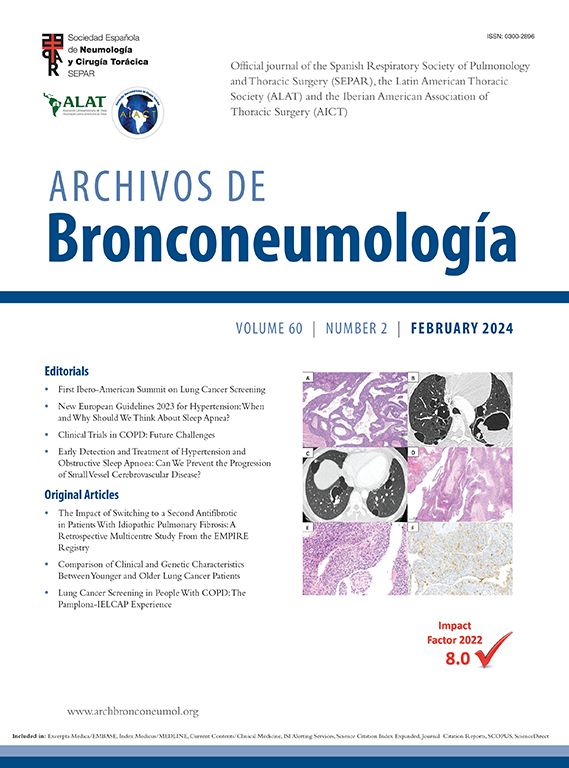Resectable Non-Small Cell Lung Cancer Heterogeneity and Recurrence Assessed by Tissue Next-Generation Sequencing Genotyping and Circulating Tumor Cell EZH2 Characterization
IF 8.7
3区 医学
Q1 RESPIRATORY SYSTEM
引用次数: 0
Abstract
Introduction
Non-small cell lung cancer (NSCLC) is the most common type of lung neoplasm. Despite surgical resection, it has a high relapse rate, accounting for 30–55% of all cases. Next-generation sequencing (NGS) based on a customized gene panel and the analysis of circulating tumor cells (CTCs) can help identify heterogeneity, stratify high-risk patients, and guide treatment decisions. In this descriptive study involving a small prospective cohort, we focus on the phenotypic characterization of CTCs, particularly concerning EZH2 expression (a member of the Polycomb Repression Complex 2), as well as on the mutation profiles of the tissue using a customized gene panel and their association with poor outcomes in NSCLC.
Methods
Isolation and characterization of EZH2 on CTCs were evaluated before surgical resection (CTC1) and one month after surgery (CTC2) in resectable NSCLC patients. Targeted NGS was performed using a customized 50-gene panel on tissue samples from a subset of patients.
Results
76 patients with resectable NSCLC were recruited. The top mutated genes in the cohort included TP53, FLT1, MUC5AC, EGFR, and NLRP3. Pair of genes that had mutually exclusive mutations was TP53-RIN3, and pairs of genes with co-occurring mutations were CD163-TLR4, FGF10-FOXP2, ADAMTSL3-FLT1, ADAMTSL3-MUC5AC and MUC5AC-NLRP3. CTCs decreased significantly between the two time points CTC1 and CTC2 (p < 0.0001), and CTCs+ patients with high EZH2 expression had an 87% increased risk of death (p = 0.018).
Conclusions
Integrating molecular profiling of tumors and CTC characterization can provide valuable insights into tumor heterogeneity and improve patient stratification for resectable NSCLC.

通过组织新一代测序基因分型和循环肿瘤细胞 EZH2 特征评估可切除的非小细胞肺癌异质性和复发率
导言非小细胞肺癌(NSCLC)是最常见的肺部肿瘤。尽管进行了手术切除,但它的复发率很高,占所有病例的 30-55%。基于定制基因面板的下一代测序(NGS)和循环肿瘤细胞(CTCs)分析有助于识别异质性、对高风险患者进行分层并指导治疗决策。在这项涉及小型前瞻性队列的描述性研究中,我们重点研究了 CTC 的表型特征,尤其是 EZH2(多聚核抑制复合体 2 的成员)的表达,以及使用定制基因面板的组织突变图谱及其与 NSCLC 不良预后的关联:方法:对可切除 NSCLC 患者手术切除前(CTC1)和术后一个月(CTC2)CTC 上 EZH2 的分离和特征进行了评估。使用定制的 50 个基因面板对部分患者的组织样本进行了靶向 NGS 研究:结果:共招募了 76 名可切除 NSCLC 患者。队列中突变最多的基因包括 TP53、FLT1、MUC5AC、表皮生长因子受体和 NLRP3。出现互斥突变的基因对是TP53-RIN3,同时出现突变的基因对是CD163-TLR4、FGF10-FOXP2、ADAMTSL3-FLT1、ADAMTSL3-MUC5AC和MUC5AC-NLRP3。CTCs 在 CTC1 和 CTC2 两个时间点之间明显减少(pConclusions:将肿瘤分子图谱分析与 CTC 特征描述相结合,可以为了解肿瘤异质性提供有价值的信息,并改善可切除 NSCLC 患者的分层。
本文章由计算机程序翻译,如有差异,请以英文原文为准。
求助全文
约1分钟内获得全文
求助全文
来源期刊

Archivos De Bronconeumologia
Medicine-Pulmonary and Respiratory Medicine
CiteScore
3.50
自引率
17.50%
发文量
330
审稿时长
14 days
期刊介绍:
Archivos de Bronconeumologia is a scientific journal that specializes in publishing prospective original research articles focusing on various aspects of respiratory diseases, including epidemiology, pathophysiology, clinical practice, surgery, and basic investigation. Additionally, the journal features other types of articles such as reviews, editorials, special articles of interest to the society and editorial board, scientific letters, letters to the editor, and clinical images. Published monthly, the journal comprises 12 regular issues along with occasional supplements containing articles from different sections.
All manuscripts submitted to the journal undergo rigorous evaluation by the editors and are subjected to expert peer review. The editorial team, led by the Editor and/or an Associate Editor, manages the peer-review process. Archivos de Bronconeumologia is published monthly in English, facilitating broad dissemination of the latest research findings in the field.
 求助内容:
求助内容: 应助结果提醒方式:
应助结果提醒方式:


